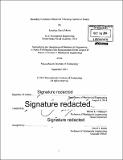| dc.contributor.advisor | Martin L. Culpepper. | en_US |
| dc.contributor.author | Monti, Jonathan David | en_US |
| dc.contributor.other | Massachusetts Institute of Technology. Department of Mechanical Engineering. | en_US |
| dc.date.accessioned | 2015-04-08T18:02:56Z | |
| dc.date.available | 2015-04-08T18:02:56Z | |
| dc.date.copyright | 2014 | en_US |
| dc.date.issued | 2014 | en_US |
| dc.identifier.uri | http://hdl.handle.net/1721.1/96463 | |
| dc.description | Thesis: S.M., Massachusetts Institute of Technology, Department of Mechanical Engineering, 2014. | en_US |
| dc.description | Cataloged from PDF version of thesis. | en_US |
| dc.description | Includes bibliographical references (pages 104-106). | en_US |
| dc.description.abstract | Compliant mechanisms continue to see increased used in many areas of modem engineering. Their low cost, ease of production and manufacturing, and precision of motion have made them attractive solutions to many controlled motion systems such as nanopositioners or linear platforms. However, in some applications the stiffness requirements for the devices to function properly and the stiffness requirements for devices to survive outside effects such at vibration or impulse create a conflict which cannot be rectified with traditional engineering approaches. By utilizing boundary controls which acted only when a flexure reached a certain deflection, the original purpose of the device could be preserved while also reducing or eliminating the risk of failure from plastic deformation or brittle failure. By starting with the most basic of compliant mechanisms, the cantilever beam, and utilizing Buckingham Pi theory the dynamic behavior of the vibrating beams could be quantified and the associated variables used to tailor the design of a flexure and boundary control system. This research details the primary correlation between variables in a flexure system during natural frequency excitation and provides the mathematics necessary to implement boundary controls to prevent flexure failure. With this new information, cantilever style flexures can now be designed to operate in environments which previously would have put them at risk of catastrophic failure, and can allow for three to four times the increased range performance of a compliant mechanism in these environments without risk of failure. Furthermore, this research lays the foundation for the study of more complex flexures and multi degree-of-freedom systems. | en_US |
| dc.description.statementofresponsibility | by Jonathan David Monti. | en_US |
| dc.format.extent | 106 pages | en_US |
| dc.language.iso | eng | en_US |
| dc.publisher | Massachusetts Institute of Technology | en_US |
| dc.rights | M.I.T. theses are protected by copyright. They may be viewed from this source for any purpose, but reproduction or distribution in any format is prohibited without written permission. See provided URL for inquiries about permission. | en_US |
| dc.rights.uri | http://dspace.mit.edu/handle/1721.1/7582 | en_US |
| dc.subject | Mechanical Engineering. | en_US |
| dc.title | Boundary condition effects on vibrating cantilever beams | en_US |
| dc.type | Thesis | en_US |
| dc.description.degree | S.M. | en_US |
| dc.contributor.department | Massachusetts Institute of Technology. Department of Mechanical Engineering | |
| dc.identifier.oclc | 905973678 | en_US |
